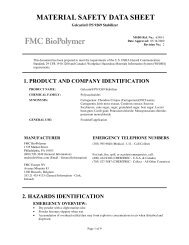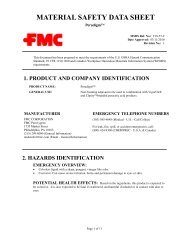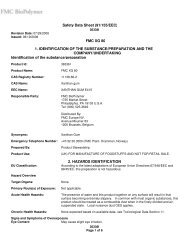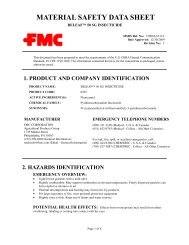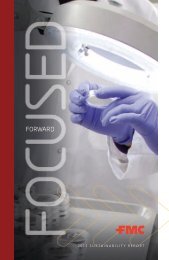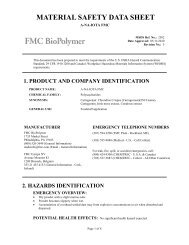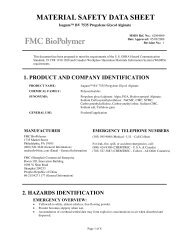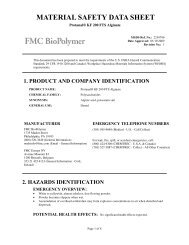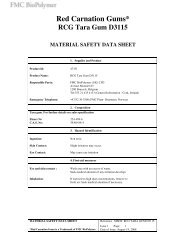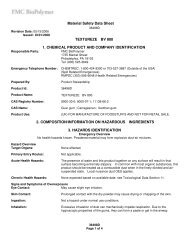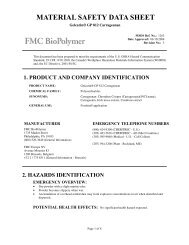CAPTURE® 2 EC INSECTICIDE/MITICIDE - FMC Corporation
CAPTURE® 2 EC INSECTICIDE/MITICIDE - FMC Corporation
CAPTURE® 2 EC INSECTICIDE/MITICIDE - FMC Corporation
Create successful ePaper yourself
Turn your PDF publications into a flip-book with our unique Google optimized e-Paper software.
MATERIAL SAFETY DATA SHEET<br />
<strong>CAPTURE®</strong> 2 <strong>EC</strong> INS<strong>EC</strong>TICIDE/<strong>MITICIDE</strong><br />
Page 1 of 14<br />
MSDS Ref. No.: 82657-04-3-57<br />
Date Approved: 06/23/2006<br />
Revision No.: 21<br />
This document has been prepared to meet the requirements of the U.S. OSHA Hazard Communication<br />
Standard, 29 CFR 1910.1200; the <strong>EC</strong> directive, 2001/58/<strong>EC</strong> and other regulatory requirements. The<br />
information contained herein is for the concentrate as packaged, unless otherwise noted.<br />
1. PRODUCT AND COMPANY IDENTIFICATION<br />
PRODUCT NAME: <strong>CAPTURE®</strong> 2 <strong>EC</strong> INS<strong>EC</strong>TICIDE/<strong>MITICIDE</strong><br />
PRODUCT CODE: 777; 6196<br />
ACTIVE INGREDIENT(S): Bifenthrin<br />
CHEMICAL FAMILY: Pyrethroid Pesticide<br />
MOL<strong>EC</strong>ULAR FORMULA: (bifenthrin)<br />
SYNONYMS: <strong>FMC</strong> 54800; (2-methyl[1,1'-biphenyl]-3-yl)methyl 3-(2-chloro-3,3,3trifluoro-1-propenyl)-2,2-dimethylcyclopropanecarboxylate;<br />
IUPAC:<br />
2-methylbiphenyl-3-ylmethyl (Z)-(1RS)-cis-3-(2-chloro-3,3,3trifluoroprop-1-enyl)-2,2-dimethylcyclopropanecarboxylate<br />
MANUFACTURER<br />
<strong>FMC</strong> CORPORATION<br />
Agricultural Products Group<br />
1735 Market Street<br />
Philadelphia, PA 19103<br />
(215) 299 6000 (General Information)<br />
2. HAZARDS IDENTIFICATION<br />
EMERGENCY TELEPHONE NUMBERS<br />
(800) 331-3148 (<strong>FMC</strong> - U.S.A. & Canada)<br />
(716) 735-3765 (<strong>FMC</strong> - Reverse charges)<br />
For leak, fire, spill, or accident emergencies, call:<br />
(800) 424-9300 (CHEMTR<strong>EC</strong> - U.S.A. & Canada)<br />
(703) 527-3887 (CHEMTR<strong>EC</strong> - All Other Countries)<br />
EMERGENCY OVERVIEW:<br />
• Amber liquid with an aromatic hydrocarbon odor.<br />
• Moderately combustible. May support combustion if heated above the product's flash point (see<br />
Section 9, "Physical and Chemical Properties" below).<br />
• Thermal decomposition and burning may form toxic by-products.<br />
• For large exposures or fire, wear personal protective equipment.<br />
• Highly toxic to fish and aquatic organisms. Keep out of drains and water courses.<br />
• Moderate oral toxicity.
<strong>CAPTURE®</strong> 2 <strong>EC</strong> INS<strong>EC</strong>TICIDE/<strong>MITICIDE</strong> (82657-04-3-57) Date: 06/23/2006<br />
POTENTIAL HEALTH EFF<strong>EC</strong>TS: Effects from overexposure result from either<br />
swallowing or coming into contact with the skin. Symptoms of overexposure include tremors, convulsions,<br />
incoordination, decreased locomotion and nasal discharge. Contact with bifenthrin may occasionally<br />
produce skin sensations such as rashes, numbing, burning or tingling. These skin sensations are reversible<br />
and usually subside within 12 hours.<br />
MEDICAL CONDITIONS AGGRAVATED: None presently known.<br />
3. COMPOSITION / INFORMATION ON INGREDIENTS<br />
Chemical Name CAS# Wt.% <strong>EC</strong> No. <strong>EC</strong> Class<br />
Bifenthrin 82657-04-3 25.1 None R25-20-43-50/53; S1/2-23-<br />
24-37-38-45-29<br />
Aromatic Hydrocarbons 64742-95-6 22 - 36 265-199-0 R10-37-51/53-65-66-67;<br />
S23-24-43A-57-60-62<br />
1,2,4-trimethylbenzene 95-63-6 11 - 19 202-436-9 R10-20-36/37/38-51/53;<br />
S2-26-61<br />
Xylene 1330-20-7 1.1 - 2 215-535-7 R10-20/21-38; S2-25<br />
Surfactant Blend
<strong>CAPTURE®</strong> 2 <strong>EC</strong> INS<strong>EC</strong>TICIDE/<strong>MITICIDE</strong> (82657-04-3-57) Date: 06/23/2006<br />
INHALATION: Remove to fresh air. If breathing difficulty or discomfort occurs and persists, obtain<br />
medical attention.<br />
NOTES TO MEDICAL DOCTOR: This product has moderate oral and, low dermal and<br />
inhalation toxicity. It is minimally irritating to the eyes and non-irritating to the skin. This product contains<br />
light aromatic hydrocarbons that can produce a severe pneumonitis or fatal pulmonary edema if aspirated<br />
during vomiting. Consideration should be given to gastric lavage with an endotracheal tube in place.<br />
Reversible skin sensations (paresthesia) may occur and ordinary skin salves have been found useful in<br />
reducing discomfort. Treatment is otherwise controlled removal of exposure followed by symptomatic and<br />
supportive care.<br />
5. FIRE FIGHTING MEASURES<br />
EXTINGUISHING MEDIA: Foam, CO2 or dry chemical. Soft stream water fog only if<br />
necessary. Contain all runoff.<br />
FIRE / EXPLOSION HAZARDS: Moderately combustible. When heated above the flash<br />
point, this material releases vapors which, when mixed with air, can burn or be explosive.<br />
FIRE FIGHTING PROCEDURES: Isolate fire area. Evacuate downwind. Wear full<br />
protective clothing and self-contained breathing apparatus. Do not breathe smoke, gases or vapors<br />
generated.<br />
6. ACCIDENTAL RELEASE MEASURES<br />
RELEASE NOTES: Isolate and post spill area. Wear protective clothing and personal protective<br />
equipment as prescribed in Section 8, "Exposure Controls/Personal Protection". Keep unprotected persons<br />
and animals out of the area.<br />
Keep material out of lakes, streams, ponds and sewer drains. Dike to confine spill and absorb with a noncombustible<br />
absorbent such as clay, sand or soil. Vacuum, shovel or pump waste into a drum and label<br />
contents for disposal.<br />
To clean and neutralize contaminated area, scrub area with a solution of detergent (e.g. commercial product<br />
such as SuperSoap, Tide®, Spic and Span®, or other high pH detergent) and water. Let solution sit for 5<br />
minutes. Use a stiff brush to scrub affected area. Repeat if necessary to remove visible staining.<br />
Additional decontamination can be made by applying bleach (Clorox® or equivalent) to affected area.<br />
Absorb wash-liquid as noted above, remove visibly contaminated soil and place into recovery / disposal<br />
container (plastic, open-top steel drum or equivalent). Place all clean-up material in a container, seal and<br />
dispose of in accordance with the method outlined in Section 13 "Disposal Considerations" below.<br />
For further information on spill clean-up, waste disposal, or return of salvaged product, call the <strong>FMC</strong><br />
Emergency Hotline number listed in Section 1 "Product and Company Identification" above.<br />
Page 3 of 14
<strong>CAPTURE®</strong> 2 <strong>EC</strong> INS<strong>EC</strong>TICIDE/<strong>MITICIDE</strong> (82657-04-3-57) Date: 06/23/2006<br />
7. HANDLING AND STORAGE<br />
HANDLING AND STORAGE: Store in a cool, dry, well-ventilated place. Do not use or<br />
store near heat, open flame or hot surfaces. Store in original containers only. Keep out of reach of children<br />
and animals. Do not freeze. Do not store below 4°C (40°F). If crystals are observed, warm material to<br />
above 15°C (60°F) by room heating only. Do not use external source of heat for warming container. Shake<br />
container periodically to re-dissolve crystals. Do not contaminate other pesticides, fertilizers, water, food or<br />
feed by storage or disposal.<br />
8. EXPOSURE CONTROLS / PERSONAL PROT<strong>EC</strong>TION<br />
EXPOSURE LIMITS<br />
Chemical Name ACGIH OSHA Supplier<br />
Aromatic<br />
Hydrocarbons<br />
1,2,4-trimethylbenzene<br />
Xylene<br />
Cumene<br />
Ethylbenzene<br />
1-butanol<br />
150 ppm (STEL)<br />
50 ppm (TWA)<br />
100 ppm (TWA)<br />
434 mg/m 3 (TWA)<br />
543 mg/m 3 (STEL)<br />
125 ppm (STEL)<br />
20 ppm (TWA) (ceiling)<br />
Page 4 of 14<br />
25 ppm (PEL)<br />
100 ppm (PEL)<br />
50 ppm (PEL) (skin)<br />
100 ppm (PEL)<br />
434 mg/m 3 (PEL)<br />
100 ppm (TWA) (ceiling)<br />
50 ppm (PEL) (ceiling)<br />
18 ppm<br />
ENGINEERING CONTROLS: Use local exhaust at all process locations where vapor or<br />
mist may be emitted. Ventilate all transport vehicles prior to unloading.<br />
PERSONAL PROT<strong>EC</strong>TIVE EQUIPMENT<br />
EYES AND FACE: For splash, mist or spray exposure, wear chemical protective goggles<br />
or a face shield.<br />
RESPIRATORY: For splash, mist or spray exposures wear, as a minimum, a properly<br />
fitted half-face or full-face air-purifying respirator which is approved for pesticides (U.S.<br />
NIOSH/MSHA, EU CEN or comparable certification organization). Respirator use and selection<br />
must be based on airborne concentrations.
<strong>CAPTURE®</strong> 2 <strong>EC</strong> INS<strong>EC</strong>TICIDE/<strong>MITICIDE</strong> (82657-04-3-57) Date: 06/23/2006<br />
PROT<strong>EC</strong>TIVE CLOTHING: Depending upon concentrations encountered, wear<br />
coveralls or long-sleeved uniform and head covering. For larger exposures as in the case of spills,<br />
wear full body cover barrier suit, such as a PVC suit. Leather items - such as shoes, belts and<br />
watchbands - that become contaminated should be removed and destroyed. Launder all work<br />
clothing before reuse (separately from household laundry).<br />
GLOVES: Wear chemical protective gloves made of materials such as nitrile, neoprene or<br />
Viton® brand. Thoroughly wash the outside of gloves with soap and water prior to removal.<br />
Inspect regularly for leaks.<br />
WORK HYGIENIC PRACTICES: Clean water should be available for washing in case of<br />
eye or skin contamination. Wash skin prior to eating, drinking, chewing gum, or using tobacco. Shower at<br />
the end of the workday.<br />
9. PHYSICAL AND CHEMICAL PROPERTIES<br />
ODOR: Aromatic hydrocarbon<br />
APPEARANCE: Amber liquid<br />
DENSITY / WEIGHT PER VOLUME: 7.8 - 8.0 lb/gal. (940 - 960 g/L)<br />
FLASH POINT: 42 °C (108 °F) (CC)<br />
MOL<strong>EC</strong>ULAR WEIGHT: 422.88 (bifenthrin)<br />
SOLUBILITY IN WATER: Emulsifies<br />
SP<strong>EC</strong>IFIC GRAVITY: 0.94 - 0.96 @ 20°C (water = 1)<br />
10. STABILITY AND REACTIVITY<br />
CONDITIONS TO AVOID: Excessive heat and fire.<br />
STABILITY: Stable<br />
POLYMERIZATION: Will not occur<br />
HAZARDOUS D<strong>EC</strong>OMPOSITION PRODUCTS: Carbon monoxide, carbon dioxide, hydrogen<br />
chloride and hydrogen fluoride.<br />
11. TOXICOLOGICAL INFORMATION<br />
EYE EFF<strong>EC</strong>TS: Minimally irritating<br />
SKIN EFF<strong>EC</strong>TS: Non-irritating<br />
Page 5 of 14
<strong>CAPTURE®</strong> 2 <strong>EC</strong> INS<strong>EC</strong>TICIDE/<strong>MITICIDE</strong> (82657-04-3-57) Date: 06/23/2006<br />
DERMAL LD50: > 2,000 mg/kg (rabbit)<br />
ORAL LD50: 262 mg/kg (rat)<br />
INHALATION LC50: 1.86 mg/l (4 h) (rat)<br />
SENSITIZATION: This product produces skin sensitization (allergic reaction) in laboratory<br />
animals, and may produce similar effects in humans.<br />
ACUTE EFF<strong>EC</strong>TS FROM OVEREXPOSURE: This product has moderate oral and,<br />
low dermal and inhalation toxicity. It is minimally irritating to the eyes and non-irritating to the skin. Signs<br />
of toxicity in laboratory animals included tremors, clonic convulsions, ataxia, decreased locomotion,<br />
bloody tears and bloody nasal discharge. Bifenthrin does not cause acute delayed neurotoxicity. Experience<br />
to date indicates that contact with bifenthrin may occasionally produce skin sensations such as rashes,<br />
numbing, burning or tingling. These sensations are reversible and usually subside within 12 hours.<br />
Inhalation of aromatic hydrocarbon vapors may cause dizziness, disturbances in vision, drowsiness,<br />
respiratory irritation, and eye, skin and mucous membrane irritation. Vomiting after ingestion of this<br />
product may cause aspiration of aromatic hydrocarbons into the lungs, which may result in fatal pulmonary<br />
edema. Exposure to butanol vapors may produce headaches, drowsiness and irritation of the nose and<br />
throat. Excessive exposures to butanol liquid or vapors may result in contact dermatitis and irritation of the<br />
mucous membranes.<br />
CHRONIC EFF<strong>EC</strong>TS FROM OVEREXPOSURE: No data available for the<br />
formulation. In studies with laboratory animals, bifenthrin did not cause reproductive toxicity or<br />
teratogenicity. Tremors were associated with repeated exposure of laboratory animals to bifenthrin. In<br />
lifetime feeding studies conducted with rodents, a slight increase in the incidence of urinary bladder tumors<br />
at the highest dose in male mice was considered to be an equivocal response, not evidence of a clear<br />
compound-related effect. The overall absence of genotoxicity has been demonstrated in mutagenicity tests<br />
with bifenthrin. Chronic exposure to aromatic hydrocarbons may cause headaches, dizziness, loss of<br />
sensations or feelings (such as numbness), and liver and kidney damage. Inhalation of xylene vapors at high<br />
doses has also resulted in an increased incidence of malformations and decreases in fetal weight in<br />
laboratory animals. Damage from xylene may be potentiated by alcohol. Disturbances in hearing and<br />
balance have been reported in workers exposed to butanol vapors. Under the conditions of 2-year inhalation<br />
studies, conducted by the National Toxicology Program (NTP), there was clear evidence of carcinogenic<br />
activity of ethylbenzene in male rats based on increased incidences of renal tubule neoplasms. The<br />
incidences of testicular adenoma were also increased. There was some evidence of carcinogenic activity in<br />
female rats based on increased incidences of renal tubule adenomas. There was some evidence of<br />
carcinogenic activity in male mice based on increased incidences of alveolar/bronchiolar neoplasm. There<br />
was some evidence of carcinogenic activity in female mice based on increased incidences of hepatocellular<br />
neoplasms. Studies conducted by the International Agency for Research on Cancer (IARC) showed that<br />
there is inadequate evidence in humans for the carcinogenicity of ethylbenzene and that there is sufficient<br />
evidence in experimental animals; therefore, the overall evaluation shows that ethylbenzene is possibly<br />
carcinogenic to humans (Group 2B).<br />
CARCINOGENICITY:<br />
Chemical Name IARC NTP OSHA Other<br />
Ethylbenzene Listed Listed Not listed (ACGIH) Not listed<br />
Page 6 of 14
<strong>CAPTURE®</strong> 2 <strong>EC</strong> INS<strong>EC</strong>TICIDE/<strong>MITICIDE</strong> (82657-04-3-57) Date: 06/23/2006<br />
12. <strong>EC</strong>OLOGICAL INFORMATION<br />
Unless otherwise indicated, the data presented below are for the active ingredient.<br />
ENVIRONMENTAL DATA: Bifenthrin has moderate stability in the soil under aerobic<br />
conditions (half-life range from 65 - 125 days depending on soil type) and is stable at a wide range of pH<br />
values. Bifenthrin has a high Log Pow (6.6), a high affinity for organic matter, and is not mobile in soil.<br />
Therefore, there is little potential for movement into ground water. There is the potential for bifenthrin to<br />
bioconcentrate (BCF 2,150 mg/kg).<br />
13. DISPOSAL CONSIDERATIONS<br />
DISPOSAL METHOD: Open dumping or burning of this material or its packaging is prohibited.<br />
If spilled material cannot be disposed of by use according to label instructions, an acceptable method of<br />
disposal is to incinerate in accordance with local, state and national environmental laws, rules, standards<br />
and regulations. However, because acceptable methods of disposal may vary by location and regulatory<br />
requirements may change, the appropriate agencies should be contacted prior to disposal.<br />
EMPTY CONTAINER: Non-returnable containers that held this material should be cleaned,<br />
prior to disposal, by triple rinsing. Containers which held this material may be cleaned by being triplerinsed,<br />
and recycled, with the rinsate being incinerated. Do not cut or weld metal containers. Vapors that<br />
form may create an explosion hazard.<br />
14. TRANSPORT INFORMATION<br />
U.S. DEPARTMENT OF TRANSPORTATION (DOT)<br />
PACKAGING TYPE: Non-Bulk<br />
PROPER SHIPPING NAME: Pyrethroid pesticide, liquid, toxic,<br />
flammable<br />
T<strong>EC</strong>HNICAL NAME(S): Bifenthrin, Aromatic hydrocarbons<br />
PRIMARY HAZARD CLASS / DIVISION: 6.1<br />
HAZARD CLASS, SUBSIDIARY: 3<br />
UN/NA NUMBER: UN 3351<br />
Page 7 of 14
<strong>CAPTURE®</strong> 2 <strong>EC</strong> INS<strong>EC</strong>TICIDE/<strong>MITICIDE</strong> (82657-04-3-57) Date: 06/23/2006<br />
PACKING GROUP: III<br />
LABEL(S): 6.1, 3<br />
PLACARD(S): 6.1<br />
MARKING(S): Pyrethroid pesticide, liquid, toxic,<br />
flammable (bifenthrin, aromatic<br />
hydrocarbons), UN3351<br />
PACKAGING TYPE: Bulk<br />
PROPER SHIPPING NAME: Pyrethroid pesticide, liquid, toxic,<br />
flammable<br />
T<strong>EC</strong>HNICAL NAME(S): Bifenthrin, Aromatic hydrocarbons<br />
PRIMARY HAZARD CLASS / DIVISION: 6.1<br />
HAZARD CLASS, SUBSIDIARY: 3<br />
UN/NA NUMBER: UN 3351<br />
PACKING GROUP: III<br />
MARINE POLLUTANT: Bifenthrin<br />
LABEL(S): 6.1, 3<br />
PLACARD(S): 6.1<br />
MARKING(S): 3351<br />
ADDITIONAL INFORMATION: Xylene is a Reportable Quantity when in<br />
packages containing 9259.26 pounds<br />
(1170.6 gallons) or more of this product.<br />
INTERNATIONAL MARITIME DANGEROUS GOODS (IMDG)<br />
PACKAGING TYPE: Non-Bulk<br />
PROPER SHIPPING NAME: Pyrethroid pesticide, liquid, toxic,<br />
flammable<br />
T<strong>EC</strong>HNICAL NAME(S): Bifenthrin, Aromatic hydrocarbons<br />
PRIMARY HAZARD CLASS / DIVISION: 6.1<br />
HAZARD CLASS, SUBSIDIARY: 3<br />
UN/NA NUMBER: UN 3351<br />
PACKING GROUP: III<br />
MARINE POLLUTANT: Bifenthrin<br />
LABEL(S): 6.1, 3<br />
PLACARD(S): 6.1, 3<br />
MARKING(S): Pyrethroid pesticide, liquid, toxic,<br />
Page 8 of 14
<strong>CAPTURE®</strong> 2 <strong>EC</strong> INS<strong>EC</strong>TICIDE/<strong>MITICIDE</strong> (82657-04-3-57) Date: 06/23/2006<br />
Page 9 of 14<br />
flammable (bifenthrin, aromatic<br />
hydrocarbons), UN3351 + Marine Pollutant<br />
ADDITIONAL INFORMATION: EmS Number: F-E, S-D<br />
Flash Point: 42°C<br />
ADR - EUROPEAN AGREEMENT CONCERNING THE<br />
INTERNATIONAL CARRIAGE OF DANGEROUS GOODS BY ROAD<br />
PACKAGING TYPE: Non-Bulk<br />
PROPER SHIPPING NAME: Pyrethroid pesticide, liquid, toxic,<br />
flammable<br />
T<strong>EC</strong>HNICAL NAME(S): Bifenthrin, Aromatic hydrocarbons<br />
PRIMARY HAZARD CLASS / DIVISION: 6.1<br />
CLASSIFICATION CODE: TF2<br />
UN/NA NUMBER: UN3351<br />
PACKING GROUP: III<br />
HAZARD IDENTIFICATION NUMBER: 63<br />
MARINE POLLUTANT: Bifenthrin<br />
LABEL(S): 6.1, 3<br />
PLACARD(S): 6.1, 3<br />
MARKING(S): UN3351 + Marine Pollutant<br />
ADDITIONAL INFORMATION: Road or Rail: ADR<br />
NOTES: Packages marked in accordance<br />
with the IMDG Code are accepted for<br />
shipment.<br />
INTERNATIONAL CIVIL AVIATION ORGANIZATION (ICAO) /<br />
INTERNATIONAL AIR TRANSPORT ASSOCIATION (IATA)<br />
PACKAGING TYPE: Non-Bulk<br />
PROPER SHIPPING NAME: Pyrethroid pesticide, liquid, toxic,<br />
flammable<br />
PRIMARY HAZARD CLASS / DIVISION: 6.1<br />
SUBSIDIARY RISK: 3<br />
UN/NA NUMBER: UN3351<br />
PACKING GROUP: III<br />
LIMITED QUANTITY: Y611 / 2L
<strong>CAPTURE®</strong> 2 <strong>EC</strong> INS<strong>EC</strong>TICIDE/<strong>MITICIDE</strong> (82657-04-3-57) Date: 06/23/2006<br />
LIMITED QUANTITY: PASSENGER / CARGO: 611 / 60L<br />
LIMITED QUANTITY: CARGO: 618 / 220L<br />
OTHER INFORMATION:<br />
HARMONIZED SYSTEM<br />
Import to the U.S.A.: 3808.10.2500<br />
Export from the U.S.A.: 3808.10.0000<br />
15. REGULATORY INFORMATION<br />
UNITED STATES<br />
SARA TITLE III (SUPERFUND AMENDMENTS AND REAUTHORIZATION ACT)<br />
S<strong>EC</strong>TION 302 EXTREMELY HAZARDOUS SUBSTANCES (40 CFR 355, APPENDIX A):<br />
Not listed<br />
S<strong>EC</strong>TION 311 HAZARD CATEGORIES (40 CFR 370):<br />
Immediate, Delayed, Fire<br />
S<strong>EC</strong>TION 312 THRESHOLD PLANNING QUANTITY (40 CFR 370):<br />
The Threshold Planning Quantity (TPQ) for this product, if treated as a mixture, is 10,000 lbs;<br />
however, this product contains the following ingredients with a TPQ of less than 10,000 lbs.:<br />
None<br />
S<strong>EC</strong>TION 313 REPORTABLE INGREDIENTS (40 CFR 372):<br />
This product contains the following ingredients subject to Section 313 reporting requirements:<br />
Bifenthrin, 1,2,4-trimethylbenzene, Xylene (mixed isomers), Ethylbenzene<br />
CERCLA (COMPREHENSIVE ENVIRONMENTAL RESPONSE COMPENSATION AND<br />
LIABILITY ACT)<br />
CERCLA DESIGNATION & REPORTABLE QUANTITIES (RQ) (40 CFR 302.4):<br />
Listed<br />
Chemical Name RQ<br />
Xylene 100 lb<br />
Cumene 5,000 lb<br />
Ethylbenzene 1,000 lb<br />
1-butanol 5,000 lb<br />
FEDERAL INS<strong>EC</strong>TICIDE FUNGICIDE RODENTICIDE ACT<br />
U.S. EPA Signal Word: WARNING<br />
INTERNATIONAL LISTINGS<br />
Australian Hazard Code: 3XE<br />
HAZARD, RISK AND SAFETY PHRASE DESCRIPTIONS:<br />
Page 10 of 14
<strong>CAPTURE®</strong> 2 <strong>EC</strong> INS<strong>EC</strong>TICIDE/<strong>MITICIDE</strong> (82657-04-3-57) Date: 06/23/2006<br />
Bifenthrin:<br />
<strong>EC</strong> Symbols: T (Toxic)<br />
Xn (Harmful)<br />
N (Dangerous for the environment)<br />
<strong>EC</strong> Risk Phrases: R25 (Toxic if swallowed.)<br />
R20 (Harmful by inhalation.)<br />
R43 (May cause sensitization by skin contact.)<br />
R50/53 (Very toxic to aquatic organisms, may cause long-term adverse<br />
effects in the aquatic environment.)<br />
<strong>EC</strong> Safety Phrases: S1/2 (Keep locked up and out of reach of children.)<br />
S23 (Do not breathe gas, fumes, vapor, or spray)<br />
S24 (Avoid contact with skin.)<br />
S37 (Wear suitable gloves.)<br />
S38 (In case of insufficient ventilation, wear suitable respiratory<br />
equipment.)<br />
S45 (In case of accident or if you feel unwell, seek medical advice<br />
immediately - show the label where possible.)<br />
S29 (Do not empty into drains.)<br />
Notes For Preparation:<br />
CLASSIFICATION: Mandatory labeling (self-classification) of hazardous substances: applicable<br />
Aromatic Hydrocarbons, (Index #649-356-00-4):<br />
<strong>EC</strong> Symbols: Xn (Harmful)<br />
T (Toxic)<br />
Page 11 of 14
<strong>CAPTURE®</strong> 2 <strong>EC</strong> INS<strong>EC</strong>TICIDE/<strong>MITICIDE</strong> (82657-04-3-57) Date: 06/23/2006<br />
<strong>EC</strong> Risk Phrases: R10 (Flammable)<br />
R37 (Irritating to respiratory system.)<br />
R51/53 (Toxic to aquatic organisms, may cause long-term adverse<br />
effects in the aquatic environment.)<br />
R65 (Harmful: may cause lung damage if swallowed.)<br />
R66 (Repeated exposure may cause skin dryness or cracking.)<br />
R67 (Vapors may cause drowsiness and dizziness.)<br />
<strong>EC</strong> Safety Phrases: S23 (Do not breathe gas, fumes, vapor, or spray)<br />
S24 (Avoid contact with skin.)<br />
S43A (In case of fire use sand, earth, chemical powder or foam.)<br />
S57 (Use appropriate container to avoid environmental<br />
contamination.)<br />
S60 (This material and its container must be disposed of as<br />
hazardous waste)<br />
S62 (If swallowed, do not induce vomiting: seek medical advice<br />
immediately and show this container or label.)<br />
Notes For Preparation:<br />
Nota H applies to the product or one or more of its components. Annex 1<br />
Nota P of Annex 1 applies to the product or one or more of its components.<br />
1,2,4-trimethylbenzene, (Index #601-043-00-3):<br />
<strong>EC</strong> Symbols: Xi (Irritant)<br />
Xn (Harmful)<br />
N (Dangerous for the environment)<br />
<strong>EC</strong> Risk Phrases: R10 (Flammable)<br />
R20 (Harmful by inhalation.)<br />
R36/37/38 (Irritating to eyes, respiratory system and skin.)<br />
R51 (Toxic to aquatic organisms.)<br />
R53 (May cause long-term adverse effects in the aquatic<br />
environment.)<br />
<strong>EC</strong> Safety Phrases: S2 (Keep out of the reach of children.)<br />
S26 (In case of contact with eyes, rinse immediately with plenty of<br />
water and seek medical advice)<br />
S61 (Avoid release to the environment. Refer to special<br />
instructions/safety data sheets.)<br />
Xylene, (Index #601-022-00-9):<br />
<strong>EC</strong> Symbols: Xi (Irritant)<br />
Xn (Harmful)<br />
Page 12 of 14
<strong>CAPTURE®</strong> 2 <strong>EC</strong> INS<strong>EC</strong>TICIDE/<strong>MITICIDE</strong> (82657-04-3-57) Date: 06/23/2006<br />
<strong>EC</strong> Risk Phrases: R10 (Flammable)<br />
R20 (Harmful by inhalation.)<br />
R21 (Harmful in contact with skin.)<br />
R38 (Irritating to skin)<br />
<strong>EC</strong> Safety Phrases: S2 (Keep out of the reach of children.)<br />
S25 (Avoid contact with eyes.)<br />
Cumene, (Index #601-024-00-X):<br />
<strong>EC</strong> Symbols: Xi (Irritant)<br />
Xn (Harmful)<br />
N (Dangerous for the environment)<br />
<strong>EC</strong> Risk Phrases: R10 (Flammable)<br />
R37 (Irritating to respiratory system.)<br />
R51 (Toxic to aquatic organisms.)<br />
R53 (May cause long-term adverse effects in the aquatic<br />
environment.)<br />
R65 (Harmful: may cause lung damage if swallowed.)<br />
<strong>EC</strong> Safety Phrases: S2 (Keep out of the reach of children.)<br />
S24 (Avoid contact with skin.)<br />
S37 (Wear suitable gloves.)<br />
S61 (Avoid release to the environment. Refer to special<br />
instructions/safety data sheets.)<br />
S62 (If swallowed, do not induce vomiting: seek medical advice<br />
immediately and show this container or label.)<br />
Ethylbenzene, (Index #601-023-00-4):<br />
<strong>EC</strong> Symbols: F (Highly Flammable)<br />
Xn (Harmful)<br />
<strong>EC</strong> Risk Phrases: R11 (Highly flammable)<br />
R20 (Harmful by inhalation.)<br />
<strong>EC</strong> Safety Phrases: S2 (Keep out of the reach of children.)<br />
S16 (Keep away from sources of ignition - No Smoking.)<br />
S24 (Avoid contact with skin.)<br />
S25 (Avoid contact with eyes.)<br />
S29 (Do not empty into drains.)<br />
16. OTHER INFORMATION<br />
Page 13 of 14
<strong>CAPTURE®</strong> 2 <strong>EC</strong> INS<strong>EC</strong>TICIDE/<strong>MITICIDE</strong> (82657-04-3-57) Date: 06/23/2006<br />
REVISION SUMMARY:<br />
This MSDS replaces Revision #20, dated May 15, 2006.<br />
Changes in information are as follows:<br />
Section 12 (Ecological Information)<br />
Section 16 (Other Information)<br />
Capture and <strong>FMC</strong> Logo - <strong>FMC</strong> Trademarks<br />
Viton - E.I. du Pont de Nemours & Co. Trademark<br />
SuperSoap - Trademark of Weba Technologies, Inc.; Tide - Trademark of Proctor and Gamble; Spic and<br />
Span: Trademark of The Spic and Span Company; Clorox - Trademark of The Clorox Company<br />
© 2006 <strong>FMC</strong> <strong>Corporation</strong>. All Rights Reserved.<br />
<strong>FMC</strong> <strong>Corporation</strong> believes that the information and recommendations contained herein (including data and<br />
statements) are accurate as of the date hereof. NO WARRANTY OF FITNESS FOR ANY PARTICULAR<br />
PURPOSE, WARRANTY OF MERCHANTABILITY, OR ANY OTHER WARRANTY, EXPRESSED<br />
OR IMPLIED, IS MADE CONCERNING THE INFORMATION PROVIDED HEREIN. The information<br />
provided herein relates only to the specific product designated and may not be applicable where such<br />
product is used in combination with any other materials or in any process. Use of this product is regulated<br />
by the U.S. Environmental Protection Agency (EPA). It is a violation of Federal law to use this product in a<br />
manner inconsistent with its labeling. Further, since the conditions and methods of use are beyond the<br />
control of <strong>FMC</strong> <strong>Corporation</strong>, <strong>FMC</strong> <strong>Corporation</strong> expressly disclaims any and all liability as to any results<br />
obtained or arising from any use of the product or reliance on such information.<br />
Page 14 of 14



